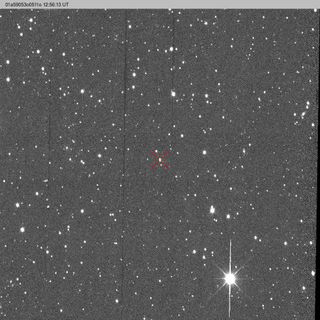NASA camera spots China's Tianwen-1 Mars spacecraft speeding away from Earth
During routine survey operations for hazardous #asteroids for @NASA’s #PlanetaryDefense Coordination Office, the @fallingstarIfA ATLAS-MLO telescope spotted China’s Tianwen-1 on its way to #Mars. Bon Voyage Tianwen-1! pic.twitter.com/Kc5SQjljgcJuly 24, 2020
Spacecraft or space rock?
An observatory affiliated with NASA's quest to identify potentially hazardous asteroids spotted something equally speedy but not quite as natural: a spacecraft bound for Mars.
That vehicle was China's Tianwen-1 Mars mission, which launched on July 23 to begin a seven-month journey to the Red Planet. The spacecraft consists of an orbiter, a lander and a rover, all packed together into what China hopes will become its first successful Mars mission.
Related: China launches ambitious Mars rover-lander-orbiter mission
The views were captured by a program run by NASA's Planetary Defense Coordination Office, which scans huge swaths of the sky for space rocks in order to gather enough observations for astronomers to map each object's path in case one may come a little too close for comfort.
The new animation of Tianwen-1 speeding away from Earth came from a facility at Mauna Loa on Hawaii Island that is one of a pair of Hawaiian observatories that make up the Asteroid Terrestrial-impact Last Alert System, or ATLAS. The ATLAS observatories regularly identify new celestial objects, like the comet of the same name that dazzled skywatchers earlier this year before fizzling out.

But in this case, it was no celestial object that streaked across ATLAS's view. Instead, it was the second in a trio of highly anticipated spacecraft launching to Mars during this summer's three-week window of orbital alignment. China hopes that the Tianwen-1 mission's three robotic components send home a bonanza of science data about the Red Planet.
Sign up for the Live Science daily newsletter now
Get the world’s most fascinating discoveries delivered straight to your inbox.
The launch was preceded by that of the United Arab Emirates' first interplanetary mission on Sunday. NASA's own Mars contribution, a massive rover called Perseverance that is also carrying a small experimental helicopter called Ingenuity, is currently scheduled to launch next Thursday (July 30).
Email Meghan Bartels at mbartels@space.com or follow her on Twitter @meghanbartels. Follow us on Twitter @Spacedotcom and on Facebook.
Meghan is a senior writer at Space.com and has more than five years' experience as a science journalist based in New York City. She joined Space.com in July 2018, with previous writing published in outlets including Newsweek and Audubon. Meghan earned an MA in science journalism from New York University and a BA in classics from Georgetown University, and in her free time she enjoys reading and visiting museums. Follow her on Twitter at @meghanbartels.

